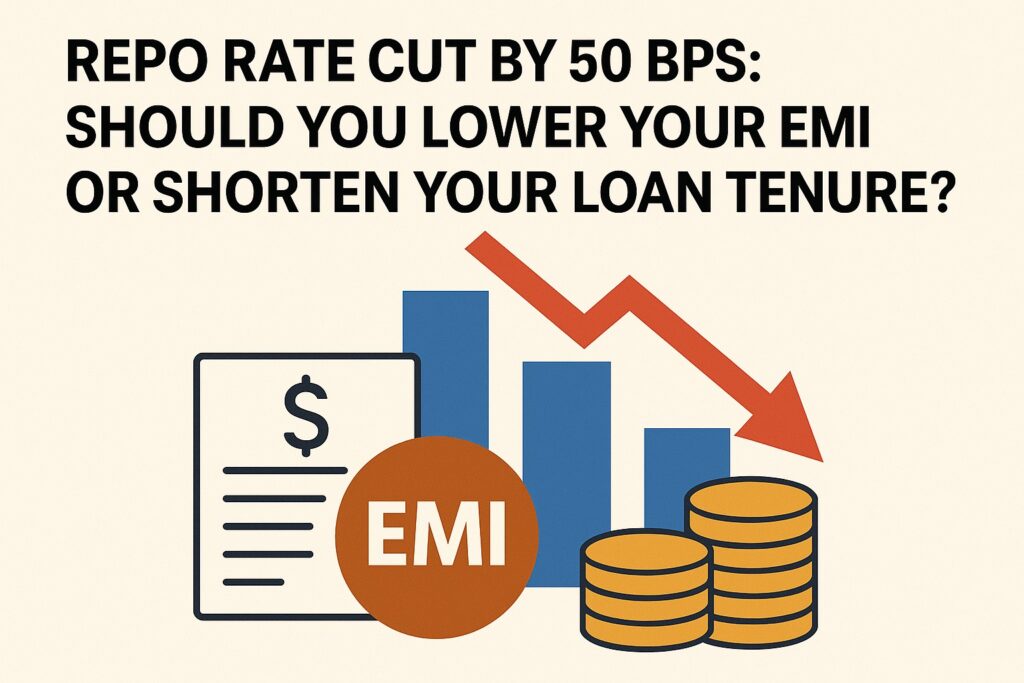Repo Rate Cut by 50 bps: Should You Lower Your EMI or Shorten Your Loan Tenure?

Repo Rate Cut by 50 bps: Should You Lower Your EMI or Shorten Your Loan Tenure?
In a move that brings welcome relief to home loan borrowers, the Reserve Bank of India (RBI) has reduced the repo rate by a total of 50 basis points this year—25 basis points each in its February and April Monetary Policy Committee (MPC) meetings. This drop in the repo rate means that, eventually, banks will lower interest rates on floating rate home loans, easing the burden on borrowers by reducing either their monthly EMIs or the loan tenure.
According to an official, these rate cuts can immediately benefit customers with floating rate home loans, depending on the reset date. Borrowers can either see their EMIs decrease or their repayment period shorten—both of which improve affordability and reduce financial pressure.
Loan Comparison Overview
Option A: Original Loan
Loan Amount: ₹40,00,000
Interest Rate: 8.50%
Tenure: 240 months
EMI: ₹34,713
Total Interest Payable: ₹43,31,103
Interest Saved: —
Tenure Reduced: —
Option B: Same Loan, Lower Rate
Loan Amount: ₹40,00,000
Interest Rate: 8.00%
Tenure: 240 months
EMI: ₹33,458
Total Interest Payable: ₹40,29,825
Interest Saved: ₹3,01,278
Tenure Reduced: —
Option C: Same Loan, Same EMI, Lower Rate
Loan Amount: ₹40,00,000
Interest Rate: 8.00%
Tenure: 220 months
EMI: ₹34,713
Total Interest Payable: ₹36,37,372
Interest Saved: ₹6,93,731
Tenure Reduced: 20 months
The figures provided are estimates. The exact values may vary based on the specific policies of each lender.
Source: BankBazaar.com
In the coming weeks, banks will likely reach out to borrowers, asking them to choose between the two options: a lower EMI or a shorter tenure. But which one will actually save you more money?
EMI vs Tenure Reduction: What’s the Smarter Choice?
While both options offer financial relief, many experts suggest that keeping your EMI the same and opting for a shorter loan tenure results in greater overall savings. A financial expert explains that maintaining the original EMI despite lower interest rates significantly reduces the total interest paid over time. Shortening the tenure helps you repay the loan faster, whereas reducing EMIs can increase your total interest outgo, despite easing monthly payments.
Let’s Look at an Example
Say you have a Rs 40 lakh floating rate home loan for 20 years at an initial interest rate of 8.5%. After a 50 basis point repo rate cut, your new interest rate is now 8%.
If you reduce your EMI:
Your EMI drops from Rs 34,713 to Rs 33,458. That’s a monthly saving of Rs 1,255. Over 20 years, assuming the interest stays at 8%, you save around Rs 3.01 lakh in total interest.
If you reduce your loan tenure instead:
You continue paying the original EMI of Rs 34,713. As a result, your loan tenure comes down from 20 years to about 18.33 years. By closing the loan roughly 20 months earlier, you save nearly Rs 6.93 lakh in interest—more than double the savings compared to EMI reduction.
Which Option Should You Choose?
While the math clearly favors tenure reduction for higher savings, not everyone may be in a position to choose that route. Another certified planner points out that tenure reduction allows more of your EMI to go toward the principal, speeding up loan repayment and maximizing savings. But if you have tight monthly budgets or other financial priorities, reducing the EMI might make more sense.
Some banks even offer a middle ground allowing you to slightly reduce both EMI and tenure. This way, you get some immediate relief while still saving on long-term interest.
Another financial expert agrees: reducing tenure is generally more cost-effective. However, each borrower’s situation is different. Your choice should depend on your financial comfort, cash flow, and long-term goals.












